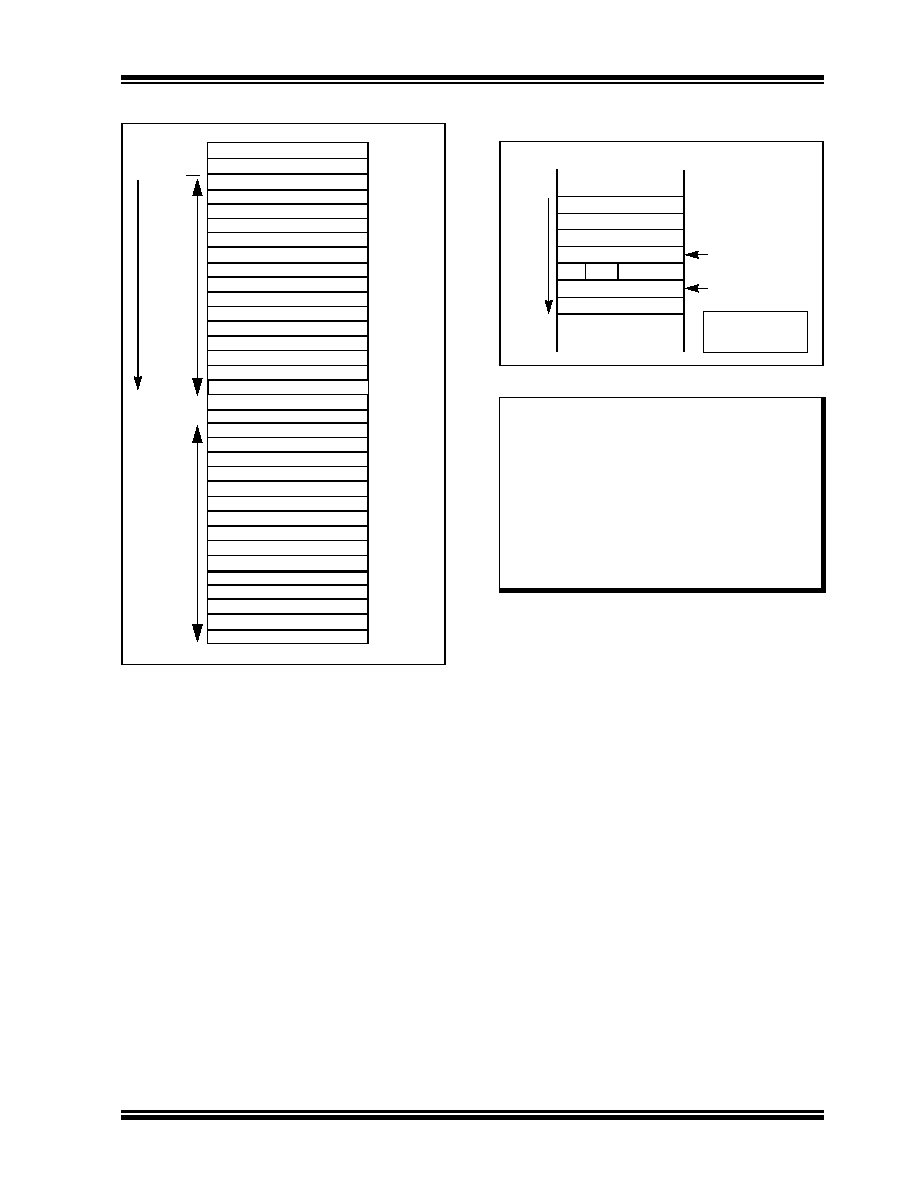- 您现在的位置:买卖IC网 > Sheet目录1917 > DSPIC30F3013-20I/ML (Microchip Technology)IC DSPIC MCU/DSP 24K 44QFN

2010 Microchip Technology Inc.
DS70139G-page 69
dsPIC30F2011/2012/3012/3013
FIGURE 8-1:
TRAP VECTORS
8.4
Interrupt Sequence
All interrupt event flags are sampled in the beginning of
each instruction cycle by the IFSx registers. A pending
Interrupt Request (IRQ) is indicated by the flag bit
being equal to a ‘1’ in an IFSx register. The IRQ causes
an interrupt to occur if the corresponding bit in the
Interrupt Enable (IECx) register is set. For the
remainder of the instruction cycle, the priorities of all
pending interrupt requests are evaluated.
If there is a pending IRQ with a priority level greater
than the current processor priority level in the IPL bits,
the processor is interrupted.
The processor then stacks the current program counter
and the low byte of the processor STATUS register
(SRL), as shown in Figure 8-2. The low byte of the
STATUS register contains the processor priority level at
the time prior to the beginning of the interrupt cycle.
The processor then loads the priority level for this
interrupt into the STATUS register. This action disables
all lower priority interrupts until the completion of the
Interrupt Service Routine (ISR).
FIGURE 8-2:
INTERRUPT STACK
FRAME
The RETFIE (return from interrupt) instruction unstacks
the program counter and STATUS registers to return
the processor to its state prior to the interrupt
sequence.
8.5
Alternate Vector Table
In program memory, the Interrupt Vector Table (IVT) is
followed by the Alternate Interrupt Vector Table (AIVT),
as shown in Figure 8-1. Access to the alternate vector
table is provided by the ALTIVT bit in the INTCON2
register. If the ALTIVT bit is set, all interrupt and
exception processes use the alternate vectors instead
of the default vectors. The alternate vectors are
organized in the same manner as the default vectors.
The AIVT supports emulation and debugging efforts by
providing a means to switch between an application
and a support environment without requiring the
interrupt vectors to be reprogrammed. This feature also
enables switching between applications for evaluation
of different software algorithms at run time.
If the AIVT is not required, the program memory
allocated to the AIVT may be used for other purposes.
AIVT is not a protected section and may be freely
programmed by the user.
Address Error Trap Vector
Oscillator Fail Trap Vector
Stack Error Trap Vector
Reserved Vector
Math Error Trap Vector
Reserved
Oscillator Fail Trap Vector
Address Error Trap Vector
Reserved Vector
Interrupt 0 Vector
Interrupt 1 Vector
—
Interrupt 52 Vector
Interrupt 53 Vector
Math Error Trap Vector
D
e
cr
easing
Pr
iorit
y
0x000000
0x000014
Reserved
Stack Error Trap Vector
Reserved Vector
Interrupt 0 Vector
Interrupt 1 Vector
—
Interrupt 52 Vector
Interrupt 53 Vector
IVT
AIVT
0x000080
0x00007E
0x0000FE
Reserved
0x000094
Reset - GOTO Instruction
Reset - GOTO Address
0x000002
Reserved
0x000082
0x000084
0x000004
Reserved Vector
Note 1: The user can always lower the priority
level by writing a new value into SR. The
Interrupt Service Routine must clear the
interrupt flag bits in the IFSx register
before lowering the processor interrupt
priority, in order to avoid recursive
interrupts.
2: The IPL3 bit (CORCON<3>) is always
clear
when
interrupts
are
being
processed. It is set only during execution
of traps.
<Free Word>
0
15
W15 (before CALL)
W15 (after CALL)
S
tack
Gr
ows
T
o
wa
rds
Higher
Addr
ess
0x0000
PC<15:0>
SRL IPL3 PC<22:16>
POP : [--W15]
PUSH : [W15++]
发布紧急采购,3分钟左右您将得到回复。
相关PDF资料
DSPIC30F4011-30I/ML
IC DSPIC MCU/DSP 48K 44QFN
DSPIC30F4013-30I/ML
IC DSPIC MCU/DSP 48K 44QFN
DSPIC30F5013-30I/PT
IC DSPIC MCU/DSP 66K 80TQFP
DSPIC30F5015-30I/PT
IC DSPIC MCU/DSP 66K 64TQFP
DSPIC30F6010-20E/PF
IC DSPIC MCU/DSP 144K 80TQFP
DSPIC30F6010A-30I/PF
IC DSPIC MCU/DSP 144K 80TQFP
DSPIC30F6013A-30I/PF
IC DSPIC MCU/DSP 132K 80TQFP
DSPIC30F6014-30I/PF
IC DSPIC MCU/DSP 144K 80TQFP
相关代理商/技术参数
dsPIC30F3013-20I/SO
功能描述:数字信号处理器和控制器 - DSP, DSC 28LD 20MIPS 24 KB RoHS:否 制造商:Microchip Technology 核心:dsPIC 数据总线宽度:16 bit 程序存储器大小:16 KB 数据 RAM 大小:2 KB 最大时钟频率:40 MHz 可编程输入/输出端数量:35 定时器数量:3 设备每秒兆指令数:50 MIPs 工作电源电压:3.3 V 最大工作温度:+ 85 C 封装 / 箱体:TQFP-44 安装风格:SMD/SMT
dsPIC30F3013-20I/SP
功能描述:数字信号处理器和控制器 - DSP, DSC 28LD 20MIPS 24 KB RoHS:否 制造商:Microchip Technology 核心:dsPIC 数据总线宽度:16 bit 程序存储器大小:16 KB 数据 RAM 大小:2 KB 最大时钟频率:40 MHz 可编程输入/输出端数量:35 定时器数量:3 设备每秒兆指令数:50 MIPs 工作电源电压:3.3 V 最大工作温度:+ 85 C 封装 / 箱体:TQFP-44 安装风格:SMD/SMT
DSPIC30F3013-30I/ML
功能描述:数字信号处理器和控制器 - DSP, DSC Sensor RoHS:否 制造商:Microchip Technology 核心:dsPIC 数据总线宽度:16 bit 程序存储器大小:16 KB 数据 RAM 大小:2 KB 最大时钟频率:40 MHz 可编程输入/输出端数量:35 定时器数量:3 设备每秒兆指令数:50 MIPs 工作电源电压:3.3 V 最大工作温度:+ 85 C 封装 / 箱体:TQFP-44 安装风格:SMD/SMT
DSPIC30F3013-30I/SO
功能描述:数字信号处理器和控制器 - DSP, DSC Sensor RoHS:否 制造商:Microchip Technology 核心:dsPIC 数据总线宽度:16 bit 程序存储器大小:16 KB 数据 RAM 大小:2 KB 最大时钟频率:40 MHz 可编程输入/输出端数量:35 定时器数量:3 设备每秒兆指令数:50 MIPs 工作电源电压:3.3 V 最大工作温度:+ 85 C 封装 / 箱体:TQFP-44 安装风格:SMD/SMT
DSPIC30F3013-30I/SO
制造商:Microchip Technology Inc 功能描述:IC DSC 16BIT 24KB 40MHZ 5.5V SOIC-28
DSPIC30F3013-30I/SP
功能描述:数字信号处理器和控制器 - DSP, DSC Sensor RoHS:否 制造商:Microchip Technology 核心:dsPIC 数据总线宽度:16 bit 程序存储器大小:16 KB 数据 RAM 大小:2 KB 最大时钟频率:40 MHz 可编程输入/输出端数量:35 定时器数量:3 设备每秒兆指令数:50 MIPs 工作电源电压:3.3 V 最大工作温度:+ 85 C 封装 / 箱体:TQFP-44 安装风格:SMD/SMT
DSPIC30F3013-30I/SP
制造商:Microchip Technology Inc 功能描述:16-Bit Digital Signal Controller
dsPIC30F3013T-20E/ML
功能描述:数字信号处理器和控制器 - DSP, DSC 44LD 20MIPS 24 KB RoHS:否 制造商:Microchip Technology 核心:dsPIC 数据总线宽度:16 bit 程序存储器大小:16 KB 数据 RAM 大小:2 KB 最大时钟频率:40 MHz 可编程输入/输出端数量:35 定时器数量:3 设备每秒兆指令数:50 MIPs 工作电源电压:3.3 V 最大工作温度:+ 85 C 封装 / 箱体:TQFP-44 安装风格:SMD/SMT